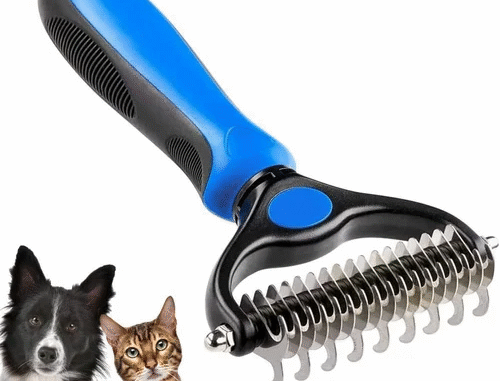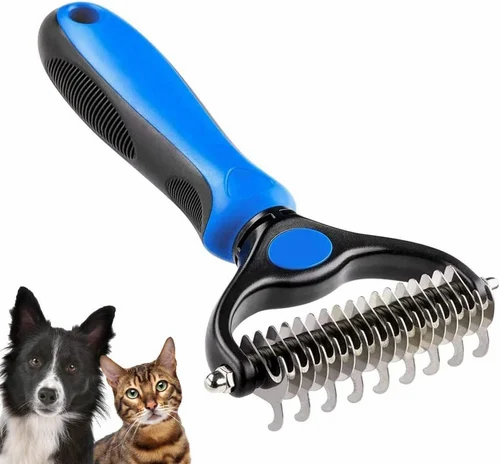
The Best Grooming Tools for Long-Haired Cats: Long-haired cats are undeniably majestic creatures, their flowing coats making them look like living royalty. However, with such beautiful fur comes a significant responsibility for their caretakers. Grooming is an essential aspect of maintaining a long-haired cat’s health, comfort, and appearance. Without proper grooming tools and techniques, long fur can become matted, tangled, and uncomfortable for the cat, leading to skin issues and other health problems.

This guide will walk you through the best grooming tools designed specifically for long-haired cats, why each tool is important, how to use them effectively, and how to create a positive grooming routine for your feline friend.
Why Grooming is Vital for Long-Haired Cats
Cats groom themselves regularly, but long-haired cats face challenges that short-haired cats do not. Their fur is prone to:
- Matting and tangles: Long fur can easily knot and tangle, especially around the armpits, belly, and behind the ears.
- Hairballs: As cats groom themselves, they ingest loose fur. Long-haired cats tend to ingest more hair, increasing the risk of hairballs.
- Skin problems: Mats trap dirt and moisture next to the skin, which can lead to irritation, infections, or hotspots.
- Overheating: Heavy, unkempt fur can cause discomfort and overheating, especially in warmer climates.
Grooming helps prevent these issues, keeps the cat comfortable, and strengthens the bond between you and your pet.
Essential Grooming Tools for Long-Haired Cats
1. Slicker Brush
Description:
A slicker brush has fine, short wires close together on a flat or slightly curved surface. It’s designed to remove loose hair, dirt, and mats from the cat’s coat.
Why it’s essential:
The slicker brush is perfect for detangling and removing loose fur before it turns into mats. It’s gentle enough for cats but effective on thick, long fur.
How to use:
- Brush gently in the direction of the fur.
- Use short strokes to work through tangles and mats.
- Avoid pressing too hard to prevent skin irritation.
2. Wide-Tooth Comb
Description:
A wide-tooth comb has spaced-apart teeth, allowing it to glide through thick fur without pulling too hard.
Why it’s essential:
After using the slicker brush, the wide-tooth comb helps work through any remaining tangles and mats without hurting the cat. It’s especially good for sensitive areas.
How to use:
- Comb gently, starting from the ends of the fur and moving upward.
- Hold the fur near the skin to reduce pulling.
- Focus on problem areas like the belly and behind the ears.
3. Dematting Tool
Description:
A dematting tool is designed specifically to break up tough mats and tangles. It usually has sharp blades or teeth that cut through mats safely.
Why it’s essential:
When mats become too tight or large, a dematting tool helps break them down without needing to shave the fur.
How to use:
- Use carefully and slowly to avoid hurting the cat.
- Work on small sections at a time.
- Never force the tool through large mats; break them down gradually.
4. Undercoat Rake
Description:
This tool features two rows of teeth that penetrate deep into the cat’s coat to remove loose undercoat fur.
Why it’s essential:
Long-haired cats often have a thick undercoat that sheds heavily. The undercoat rake helps reduce shedding by removing dead fur without damaging the topcoat.
How to use:
- Gently rake through the coat in the direction of hair growth.
- Use weekly during shedding seasons to keep fur manageable.
5. Grooming Scissors and Clippers
Description:
Scissors and clippers designed for pets are essential for trimming fur around sensitive areas like the paws, rear end, and underarms.
Why it’s essential:
Sometimes mats are too severe or close to the skin, and trimming is necessary to keep the cat comfortable.
How to use:
- Use blunt-ended scissors to avoid injury.
- Trim carefully and only the matted or overgrown fur.
- Clippers may be used by professionals or experienced owners.
6. Deshedding Tool
Description:
A deshedding tool has fine blades designed to remove loose undercoat hairs without cutting the topcoat.
Why it’s essential:
It helps control shedding, reducing hair around your home and hairballs for your cat.
How to use:
- Use in the direction of hair growth.
- Avoid overuse to prevent skin irritation.
7. Nail Clippers
Description:
Cats’ nails should be trimmed regularly to prevent overgrowth, splitting, and accidental scratches.
Why it’s essential:
While not strictly for grooming fur, nail care is part of overall grooming.
How to use:
- Use cat-specific nail clippers.
- Trim only the sharp tip to avoid the quick.
- Offer treats and praise during trimming.
READ ALSO: 5 Reasons Why Your Cat Hides and How to Help
How to Groom Your Long-Haired Cat: Step-by-Step
Step 1: Prepare the Environment
Choose a calm, quiet area where your cat feels safe. Gather all grooming tools in one place.
Step 2: Start with Brushing
Begin with a slicker brush to remove loose fur and minor tangles. Brush gently and reward your cat with treats to keep them relaxed.
Step 3: Use the Wide-Tooth Comb
Go through the fur with the comb to tackle any stubborn tangles and mats. Focus on sensitive spots.
Step 4: Dematting If Needed
If you find tight mats, carefully use the dematting tool or scissors to remove them. Don’t rush, and ensure your cat is comfortable.
Step 5: Use the Undercoat Rake and Deshedding Tool
These tools help reduce shedding and maintain the coat’s health. Use them weekly during shedding seasons.
Step 6: Check Nails and Trim if Necessary
After brushing, check your cat’s nails and trim them carefully.
Step 7: Finish with Praise and Reward
Make grooming a positive experience by rewarding your cat with playtime or treats.
Tips for Grooming Long-Haired Cats
- Start grooming early: Begin grooming your cat when they are young to get them used to the process.
- Be patient: Grooming can be stressful for cats, so take your time.
- Regular grooming: Aim to groom your long-haired cat at least 3-4 times a week.
- Use treats and positive reinforcement: This helps your cat associate grooming with good experiences.
- Consult a professional groomer: For difficult mats or if you’re unsure, a professional groomer can help.
Common Grooming Challenges for Long-Haired Cats
- Fear or anxiety: Some cats resist grooming. Use calming techniques or pheromone sprays.
- Mats near sensitive areas: Take extra care when grooming around the belly and armpits.
- Skin sensitivity: Avoid over-brushing or using harsh tools.
FAQs
How often should I groom my long-haired cat?
Ideally, long-haired cats should be groomed 3-4 times a week to prevent mats and tangles. Daily grooming may be necessary during heavy shedding seasons.
Can I use human brushes on my cat?
It’s not recommended. Human brushes may have bristles that are too harsh or too soft and may not be effective for cat fur. Use brushes designed for cats instead.
What if my cat hates grooming?
Try to make grooming a positive experience with treats and praise. Keep sessions short and calm. If needed, consult a vet or professional groomer for advice.
How do I prevent mats from forming?
Regular grooming, especially brushing and combing, helps prevent mats. Keep the fur clean and dry, and remove loose hair frequently.
Is it okay to shave my long-haired cat?
Shaving is generally a last resort for severe mats or health reasons. Consult a vet or professional groomer before shaving, as the cat’s fur protects them from temperature extremes.
Can grooming reduce hairballs?
Yes. Grooming removes loose hair before the cat ingests it, reducing hairballs and related digestive issues.
What if I find a mat too difficult to remove?
Don’t force it. Use a dematting tool or scissors carefully, or seek professional grooming help.
Leave a Reply
You must be logged in to post a comment.